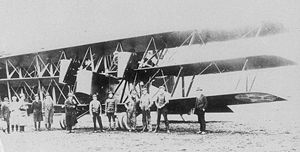Boeing GA-1 Video - Picture

|
|
Boeing GA-1
GA-1

Picture - Engineering Division/Boeing GA-1
Role: Ground attack
Manufacturer: Boeing
Designed by: Isaac M. Laddon
First flight: May 1920
Introduced: 1921
Primary user: USAAS
Number built: 10
The Boeing GA-1 (company designation Model 10) were armored triplanes. Designed in 1919, it was powered by a pair of modified Liberty engines driving pusher propellers. The first of the Engineering Division's heavily-armored GAX series (ground attack, experimental) aircraft, the ponderous airplane was intended to strafe ground troops while remaining immune to attack from the ground as well as from other enemy aircraft. It was so well armored its five-ton weight proved excessive.
History
Origins
Soon after the end of WW I, the US Army sought to explore highly-armored and -armed specialist ground attack aircraft. This was a pet project of General William Mitchell. The Army Air Service Engineering Division issued requests for proposals to U.S. aircraft producers on October 15, 1919. There were no designs offered, so the Engineering Division ordered one of its engineers, Isaac M. Laddon, to attempt what the aviation industry clearly considered impossible. His design, designated GAX, first flew at McCook Field on May 26, 1920. The GAX was McCook Field Project P129 and wore AAS serial number 63272.
Development
On June 7, 1920, Boeing was awarded a contract for 20 production models designated GA-1. Before the first was delivered in May 1921, the order had been reduced to 10. The production aircraft wore Boeing constructors numbers 200-209 and AAC serial numbers 64146-64155. Number 64146 was evaluated at McCook as project P187.
Entry into service
The GA-1 were sent to Kelly Field, Texas, in early 1923 for service tests with the 3rd Attack Group. These tests showed the aircraft to be unacceptable. They had poor visibility and performance, particularly in rate of climb, maneuverability, and range. The aircraft suffered from noise and vibrations caused by the 3/16-inch (4.75mm)-thick armor. Take-off runs were very long by the standards of the day. The GA-1s were extremely unpopular with the pilots conducting the evaluation.
Design characteristics
Aerodynamic cleanliness was sacrificed to fields of fire for its eight machine guns. The sturdy structure was able to carry a heavy load of ammunition along with about 2,200 lb (998 kg) of armor plate. The result was an angular machine of wire-braced wooden construction with plywood and fabric covering. A rectangular-section fuselage carried the forward gunner in an open nose position, the pilot in a semi-enclosed cockpit with armored shutters for forward vision, and the rear gunner in an open dorsal position. The engines were carried in mid-wing nacelles. At the front of each nacelle was a gunner's position.
Variants
GA-1
armored triplane, one pilot and two gunners, two Liberty L-12A Vee pusher engines of 435 hp (324 kW), ten built
GA-2
biplane, one pilot and two gunners, 750 hp (559 kW) Engineering Division W-18 engine, one 37mm cannon and 6 0.3 in (7.62mm) machine guns, two built
Milestones
It was rumored the GA-1s survived until surveyed on January 14, 1926 so Kelly Field pilots could be threatened with being forced to fly them for disciplinary infractions. All were scrapped in April 1926.
Operators
United States
United States Army Air Service
Specifications (GA-1)
Data from "The Complete Encyclopedia of World Aircraft"
General characteristics
Crew: 3
Length: 33 ft 7 in (10.25 m)
Wingspan: 65 ft 6 in (19.97 m)
Height: 14 ft 3 in (4.34 m)
Wing area: 1016 ft² (94.39 m²)
Empty weight: 7,834 lb (3,553 kg)
Gross weight: 10,426 lb (4,729 kg)
Powerplant: 2 x— Liberty L-12A Pusher, 435 hp (324 kW) each each
Performance
Maximum speed: 105 mph (169 km/h)
Cruise speed: 95 mph (153 km/h)
Range: 350 miles (563 km)
Service ceiling: 11,500 ft (3,505 m)
Rate of climb: 600 ft/min (3.05 m/s)
Armament
1 x 37 mm Baldwin cannon
8 x .30 cal. Browning machine guns
With some machine guns removed, 10 small fragmentation bombs could be carried.
Wagner, Ray. American Combat Planes. Garden City, NY: Hanover House, 1968. ISBN 0385041349
Eden, Paul, & Moeng, Soph, editors. The Complete Encyclopedia of World Aircraft. London: Amber Books Ltd., 2002. ISBN 0-7607-3432-1
Boeing GA-1 Pictures
Living Warbirds: The best warbirds DVD series.
Source: WikiPedia